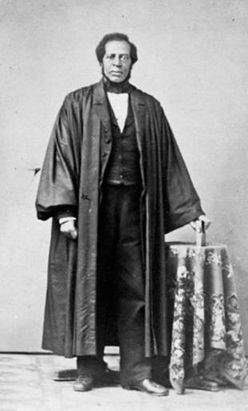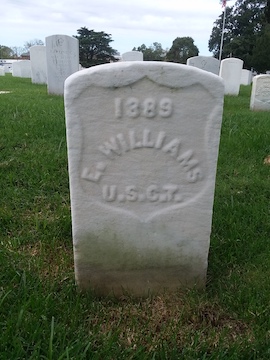Dying Far From Home: Pvt. Edward Williams, Co. C, 6th USCI

ECW is pleased to welcome back Tim Talbott, director of education and interpretation at Pamplin Historical Park
During the Civil War, soldiers sometimes attempted to describe the nature of combat to friends and loved ones unfamiliar with warfare. In the years since the conflict, scholars have also tried to give us an idea. Soldiers and historians alike have used terms such as chaos, pandemonium, and bedlam in effort to relate the stressful battlefield situations that participants experienced. Some soldiers, especially those who had previously “seen the elephant,” and thus knew what was in store, were able to steady their nerves, hear commands, and will themselves to obey those commands despite the many surrounding dangers. Others, unable to stand the potential threats to life and limb, either froze up, ran away, or found other ways to make their personal safety their main priority.
The United States Colored Troops (USCT) soldiers who fought at the Battle of New Market Heights on September 29, 1864, likely included men who ranged the wide spectrum of combatants. After all, they were human. However, the African American men who fought at New Market Heights realized this engagement presented a unique opportunity to prove themselves in battle, and as black soldiers they had unique motivations that often compelled them to subdue their fears and do their duty come what may.
We do not have eye-witness documentation to tell us how well Pvt. Edward Williams held up to the furious fire dealt out to him and his comrades of the 6th United States Colored Infantry (USCI) at New Market Heights. But, the sheer number of casualties inflicted upon the regiment does give us some understanding of the trial by fire they endured that day. Pvt. Williams’s life journey to September 29, 1864, also tells us something of his character and commitment.
Born a free person of color about 1836, in Montgomery County, Pennsylvania, most of Edward Williams’s young life went unrecorded. The earliest documentation appears to be the 1850 census in which he appears as a 13 year old “mulatto” laborer in the Montgomery County, Whitemarsh Township home of Henry (age 60) and Diana (age 42) Jackson. Also in the household are three young Jackson children: Rosan (7), James (4), and Hannah (1). Additionally listed are Edward Williams (13), Thomas Williams (19), and Susannah Cox (84). Perhaps Diana Jackson was Edward and Thomas’s mother, who had remarried to Henry Jackson and had the three youngest children with him. Susannah Cox may have been either Henry or Diana Jackson’s mother and the grandmother to the children.
It appears that Edward Williams’s next appearance in the public record is the 1860 census. In that enumeration, an Edward Williams who is African American, is living in the household of a white family in Montgomery County’s Upper Providence Township. Although the census taker recorded Edward’s age as 20, that information, which was about 4 years off, may have come by way of Martha Rambo, the head of household, who may have estimated Edward’s age.
Edward Williams also appears in a June 1863 draft registration listing for neighboring Chester County. On it Edward is a 28-year old single laborer. It was soon after Edward Williams registered for the draft that he volunteered, enlisting in Philadelphia on August 3, 1863, in Company C, 6th United States Colored Infantry. Williams’s enlistment provides a few more physical details about him. Described as 5 feet 8 inches tall, Williams’s complexion is noted as “black.”
As the 6th USCI filled with recruits, it trained at Camp William Penn, just outside of Philadelphia. Being in close proximity, perhaps Edward was able to see and communicate with family and friends during his time at Camp William Penn. Edward’s comrades of Company C came from diverse backgrounds. Included among the men were: shoemakers, barbers, farmers, miners, coopers, sailors, plasterers, teamsters, blacksmiths, gardeners, waiters, coachmen, porters, and like Edward Williams, general laborers.

Tabbed to command Company C was Captain Daniel Dill. Enoch Jackman served as 1st lieutenant. Frank Osborne held the 2nd lieutenant’s position. 1st Sgt. George Ellet served as go-between with the company officers and the enlisted men and helped keep the company in line. Unfortunately, Lt. Jackman and First Sgt. Ellet both numbered among the casualties at New Market Heights; Jackman survived but Ellet did not. Providing spiritual guidance for the regiment was Rev. Jeremiah Asher, who was only one of fourteen African American ministers that served in the United States army during the Civil War.
Following their training, the 6th USCI transferred to Fort Monroe, Virginia and participated in raids on the James and York River peninsula in eastern Virginia, freeing enslaved people and recruiting more soldiers for USCT regiments. Williams likely participated in some of these actions, but during the month of October his service records indicate that he was detailed as a waiter for the regiment’s officers. We do not know whether Williams enjoyed his time around the officers or if he found waiting on them demeaning.

In early May 1864, the 6th helped secure City Point, Virginia, a vital position at the confluence of the James and Appomattox Rivers that would become the nerve center for the Union army during its efforts against Petersburg and Richmond. On June 9, the 6th USCI participated in Maj. Gen. Benjamin Bulter’s ill-fated attempt on Petersburg, which was lightly defended at that time. During the day the infantry force under Gen. Quincy Gilmore demonstrated to the northeast of Petersburg and skirmished with the Confederates. It was either in this day’s sparing or perhaps the following day’s picket duty that Pvt. Edward Williams received an undescribed wound. It appears that Williams’s wound was serious enough to require him to spend time in a hospital, but fortunately minor enough to not keep him away from the regiment for very long.
Williams’s wound prevented him from participating in Gen. Ulysses S. Grant’s first major offensive against Petersburg, which occurred on June 15, 1864. However, his comrades in the 6th USCI did fantastic work throughout the day capturing several Confederate positions and a number of artillery pieces. During the continued fighting around Petersburg through the summer of 1864, a number of USCT men, including Pvt. Williams, served at Dutch Gap on the James River, constructing a canal in effort to bypass some of the Confederate shore batteries.
Leaving their position at Dutch Gap, the 6th USCI moved to Deep Bottom landing on the night of September 28, 1864. There they received orders to assault the Confederate position along the New Market Road about two miles to the north the following day. On the foggy morning of September 29, the 6th USCI followed closely behind the 4th USCI as they both crossed the fields and swampy ground in front of the Confederate defenders. Upon reaching the double lines of abatis obstacles placed by the rebels to slow the assault, the two black regiments started taking extremely high casualties, losing over half their men as killed, wounded, or captured. The 6th USCI lost 46 men killed, 20 fatally wounded, five missing in action, and 112 wounded. One of the badly wounded was Pvt. Edward Williams.
During the attack Williams received a gunshot wound to his abdomen. Evacuated from the field after the USCT attack eventually drove off the Confederate defenders, Williams received transportation by ship down the James River to the general hospital at Fort Monroe. There he lingered for several days until he succumbed on October 6, likely from peritonitis, a bacterial infection common with abdominal wounds.
 Today, Pvt. Edward Williams rests in peace in grave number 1389 in the Hampton National Cemetery among fellow black and white veterans who battled for the goals of abolishing slavery and maintaining the United States intact. As with many other aspects of Williams’s brief life, one wonders what his personal primary motivations were when he enlisted in the 6th USCI. Did he hope his efforts as a soldier would produce a world where he would be recognized as a citizen with all of the guarantees of the Constitution and an equal opportunity of success in life? We’ll likely never know, but his service in the United States army did help achieve those things, and so much more than he probably ever imaged for all of us in future generations. For this, we remember and thank Pvt. Edward Williams for his brave sacrifice!
Today, Pvt. Edward Williams rests in peace in grave number 1389 in the Hampton National Cemetery among fellow black and white veterans who battled for the goals of abolishing slavery and maintaining the United States intact. As with many other aspects of Williams’s brief life, one wonders what his personal primary motivations were when he enlisted in the 6th USCI. Did he hope his efforts as a soldier would produce a world where he would be recognized as a citizen with all of the guarantees of the Constitution and an equal opportunity of success in life? We’ll likely never know, but his service in the United States army did help achieve those things, and so much more than he probably ever imaged for all of us in future generations. For this, we remember and thank Pvt. Edward Williams for his brave sacrifice!
————
Tim Talbott is the Director of Education, Interpretation, Visitor Services, and Collections at Pamplin Historical Park and the National Museum of the Civil War Soldier in Petersburg, Virginia. He is also the founding member and President of the Battle of New Market Heights Memorial and Education Association. Tim maintains the “Random Thoughts on History” blog and has published articles in both book and scholarly journal format. His current project is researching soldiers captured during the Petersburg Campaign.
————
Sources:
1850 United States Census, accessed via Ancestry.com
1860 United States Census, accessed via Ancestry.com
Complied Military Service Record for Pvt. Edward Williams (6th USCI), accessed via Fold3.com
Paradis, James M. Strike the Blow for Freedom: The 6th United States Colored Infantry in the Civil War. White Mane Publishing, 2000.
————
The mission of the Battle of New Market Heights Memorial and Education Association is to commemorate and educate. We seek to erect a monument at the site of the Battle of New Market Heights honoring the United States Colored Troops who served in the Third Division of the XVIII Corps (Army of the James). Among these men were fourteen African American soldiers and two white officers who received the Medal of Honor for acts of heroism on September 29, 1864. We also seek to educate the public about this significant military victory by the United States Colored Troops. More information is available at https://battleofnewmarketheights.org. As part of a collaboration between ECW and BNMHMEA, this piece is cross-posted at their website.
Quite interesting. Thanks
Thank you for sharing his story.